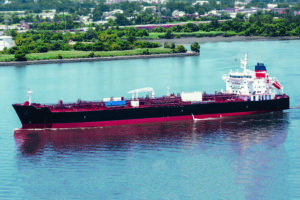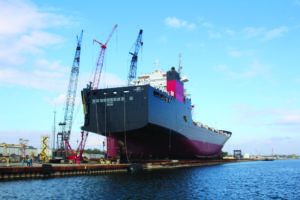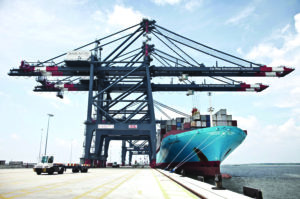Earlier this year, British Prime Minister Boris Johnson placed a big condition on a possible trade deal with the U.S. — ditch the Jones Act.
“Donald, what we want is for our ships to be able to take freight, say, from New York to Boston, which at the moment they can’t do. So, we want cabotage. How about that?” he said to President Trump at this summer’s G7 meeting. Trump’s reply: “Many things — many things we’re talking about.”
Johnson’s suggestion is just one more fire Jones Act supporters likely will fight in their effort to preserve the nearly 100-year-old law — Section 27 of the Merchant Marine Act of 1920 — that requires cargo moved from one U.S. point to another be on vessels that are U.S. built, owned and crewed.
The law is vital for national, economic and homeland security, proponents say.

Crowley Maritime's Jones Act 600', 330,000 bbl. product tanker Ohio. Crowley Maritime photo
It’s necessary for moving military equipment and supplies, it ensures U.S. mariners will be available to operate government ships in war, and it supports a shipbuilding and repair industry for both military and commercial vessels. Otherwise, the country’s waterways — including 12,000 miles of inland and intracoastal waters maintained by the Corps of Engineers — would be open to foreign ships that operate outside U.S. law. Or, as a towing company official earlier told WorkBoat, without it, “we’re going to have Pakistani tugboats pushing ammonium nitrate barges through downtown St. Louis.”
“People who understand the law, understand its value,” said Matt Paxton, president of the Shipbuilders Council of America (SCA), and a board member of the American Maritime Partnership (AMP), the industry’s Jones Act advocacy group. “If you didn’t have the Jones Act, you’d have to invent it — to police our waterways, to police our coastline.”
AMP’s figures show that the law accounts for 40,000 vessels built in U.S. shipyards, 650,000 related jobs and $150 billion in economic output.
“There are costs to doing business in the U.S.,” said Matt Woodruff, AMP president and vice president of public and government affairs at Kirby Corp., Houston. Costs, he said, that aren’t associated with international commerce, and a lot of people like to lump them together and blame the Jones Act. “The Jones Act comes down to security for America,” Woodruff said.
For instance, mariners may notice unusual things around refineries and power plants that aren’t visible on land, said Capt. Gregory Bush, president of the Associated Federal Pilots and Docking Masters of Louisiana, Metairie, La., which handles U.S.-flag vessels. “You get a different perspective from the water side.”
EDUCATION PROCESS
Getting people to understand cabotage law requires continual education, he said, citing social media as the culprit for misinformation about the Jones Act. “So many people jump at the first thing they hear.”
He’ll ask someone planning to take their kids to Disney World if they can fly Aeroflot or some other foreign carrier there to Orlando, Fla., and they don’t know why they can’t. “It’s because of cabotage,” he tells them.
U.S. law prohibits foreign airlines from taking passengers between domestic points.
“The Jones Act benefits from tremendous bipartisan support in Congress,” Paxton said, “but there’s external interest groups that attack the Jones Act. Those are real attacks and we take them seriously.”
Offshore Marine Service Association (OMSA) president Aaron Smith agrees that the law has a lot of support in Washington and among the people nationwide whose livelihoods depend on it. But that won’t stop opponents, he said. “A small number of, usually foreign, interests stand to make a lot of money if they can import foreign ships built in poor-quality, government supported shipyards and mariners from low-wage nations.”

The second of two Jones Act-compliant U.S.-flag dual fuel/LNG-powered ConRo ships for Crowley Maritime. Crowley Maritime photo
In the past few years, critics have become increasingly vocal about the law and its impact on everything from hurricane recovery and accidents to the cost of living in Hawaii, Alaska and Puerto Rico.
Those attacks are answered with ammunition such as a report commissioned by the maritime industry that concluded the law has no significant impact on consumer prices in Puerto Rico. Many food items, for instance, cost the same or less at a Walmart in San Juan than in Jacksonville, Fla., a study by Reeve & Associates and Estudios Técnicos Inc. found.
Supporters are especially diligent when it comes to waivers and interpretations of the law related to offshore installation vessels.
“The Jones Act does not need to be waived. It’s never been an impediment to anything,” Paxton said.
The law allows waivers in the interest of national defense, such as those given after major hurricanes starting with Katrina in 2005, but there’s no requirement related to vessel availability. The maritime industry points out that there’s no shortage of U.S.-flag vessels to help after disasters like Hurricane Maria in Puerto Rico in 2017. Rather the issue was a lack of trucks and clear delivery routes to move aid out of the port.
“People use the excuse of an emergency as an excuse to make money,” Woodruff said. “Those types of waivers are of concern.”
Earlier this year, Jones Act advocates mobilized after reports Trump was considering a 10-year waiver of the law for foreign-flag tankers to carry liquefied natural gas (LNG) between U.S. ports. They prevailed arguing for U.S. jobs and security.
SCA and OMSA sued Customs and Border Protection (CPB) claiming it has allowed foreign vessels to transport merchandise between U.S. points including on the Outer Continental Shelf in violation of the Jones Act. A bill before the House urges CBP to reverse its rulings, which would make it harder for foreign vessels to work offshore in the U.S. Gulf of Mexico.
With bipartisan support, the Energizing American Shipbuilding Act has been introduced in the Senate and House. The legislation would require that U.S.-built vessels transport 15% of total seaborne LNG exports by 2041 and 10% of total seaborne crude oil exports by 2033, providing a boost to the domestic maritime industry.
“Our geopolitical rivals have invested heavily in their shipbuilding capacity, and the U.S. should keep pace,” said Sen. Roger Wicker, R-Miss., a sponsor of the legislation along with Rep. John Garamendi, D-Calif.
And Paxton notes, “China was not building ships in the ‘90s. Now they dominate the world’s commerce. They dump these ships on the market.”
As for the security of the Jones Act itself, Charlie Papavizas, a partner at Winston & Strawn LLP, Chicago, and a Jones Act expert, said, “the Jones Act has substantial political support as it always has. But you never know where a threat is going to come from and free trade agreements are the devil’s playground.”
THE CASE FOR REPEAL
by Capt. Max Hardberger, Correspondent
No maritime-related legislation in U.S. history has stirred up as much emotion as the Merchant Marine Act of 1920. Today, 100 years after its passage, the Jones Act still affects the everyday lives of Americans in ways not completely understood by the general public.

A Danish-flagged container ship built in 2015 at Daewoo Shipbuilding & Marine Engineering Co. in South Korea. A.P. Moller — Maersk
The underpinnings of the current controversies over the Act’s Section 27 lie in today’s political and economic realities. The U.S. and the world have changed greatly since 1920, yet the Act remains largely the same. In 1920, there was a robust U.S. shipbuilding industry. Today, no large bluewater cargo ships are being built in the U.S. for export. According to the Congressional Research Service (CRS), “today, the price of a U.S.-built tanker is estimated to be about four times the global price of a similar vessel, while a U.S.-built containership may cost five times the global price.” Since the acquisition cost of a vessel has to be passed on ultimately to the consumer, the U.S. public pays the difference.
In terms of national security — particularly, the availability of U.S. bottoms in times of war — some argue that, with limited funds, the U.S. war effort and U.S. taxpayer would benefit from having four times the number of bottoms at the same cost, even if they have to be built in foreign yards.
Even if we had the capacity to build the types of large, oceangoing vessels needed in wartime, we can’t afford to build them in the U.S. If, as Sen. Wesley Jones persuaded Congress 100 years ago, a compelling reason for the Act was the maintenance of a fleet of dry cargo ships for war readiness, it has failed miserably.
According to the CRS, today’s U.S.-flagged dry-cargo fleet consists of “twenty-four small to medium-sized container ships, seven ships that have ramps for carrying vehicles … and two dry bulk vessels designed to carry such commodities as grain and coal in bulk form.”
Proponents of the Jones Act’s restriction on foreign ownership of vessels in cabotage often point to maritime security concerns, but every day hundreds of foreign-flag ships, crewed exclusively by foreigners, call at U.S. ports without significant security issues. Foreign-built and -owned vessels are currently servicing offshore drilling rigs in the U.S. Gulf, and there have been no reports of any security issues.
In any discussion of the Jones Act, it is essential to keep in mind its separate parts. The argument that the Act is necessary for national security is misleading. If the provision in the Act requiring U.S. crews on vessels engaged in cabotage is left intact, then the requirement that these vessels be built and repaired in the U.S. may be considered on its own merits.
Jones Act proponents say that national security requires vessels to be owned by U.S. citizens whose loyalty will drive them to support a war effort (or who can be compelled by law to do so) and requires a pre-existing supply of U.S. bottoms to carry war materiel to foreign battlefields. Both of these arguments, when divorced from manning requirements, suffer from today’s political and economic realities. First, if a U.S. citizen is free to buy and operate in cabotage a ship built at a foreign yard at 25% of the cost to build one here, then everybody benefits except the owners of U.S. shipyards.
Second, everyone, and especially the U.S. taxpayer and military, benefits from cheaper bottoms. If the U.S. can source a U.S.-flagged, foreign-built fleet four times the size of a U.S.-built fleet at the same cost, then that in itself is a boost to national security. In fact, today’s Navy recognizes this and, not being subject to the Jones Act, is considering buying foreign bottoms. In March, Gen. Steve Lyons of the U.S. Transportation Command testified before the House Committee on Armed Forces that the Navy “is contemplating the need to accelerate the purchase of used, foreign-built ships because building new ships in U.S. yards is estimated to be 26 times more expensive and thus not affordable.”
There is an argument against allowing foreign-built ships to trade between U.S. ports. Aaron Smith who heads up the Offshore Marine Service Association has sniffed at vessels being built by “poor quality, government-supported shipyards.”
But dry-cargo ships being turned out today by Chinese shipyards are built to international-class standards and are required to pass hundreds of rigorous class inspections, just like ships of this size being built anywhere in the world. Every day Chinese-built ships enter and depart U.S. ports without incident.
As for the U.S. economy, the Act hurts it, not helps it. In an article on RealClearPolicy.com (RCPC analyzes U.S. domestic policy), Thomas Grennes, emeritus professor of economics at North Carolina State University who has written extensively on the Jones Act, said that for every dollar gained by U.S. sailors, shipbuilders, and carriers as a result of the Act, U.S. consumers lose more than a dollar, resulting in a net loss.
Common sense dictates that goods going from the U.S. to Puerto Rico would have to cost more to justify the transportation expense, so we may take with a grain of salt the observation that “many food items cost the same or less at Walmarts in San Juan” than on the mainland. San Juan Walmarts may well absorb their losses on foodstuffs with higher prices on other imported goods. In fact, according to the website Numbeo.com, the overall cost of living in Puerto Rico is actually 3.22% cheaper than on the mainland but purchasing power there is 26.09% higher than in Puerto Rico. And the claim that there is “no shortage of U.S.-flagged vessels” to supply Puerto Rico glosses over the fact that most cargo from the mainland to Puerto Rico is transported by container-on-barge, not by the type of oceangoing vessels that the military would need.
Further, there’s no denying that Hawaii, also dependent on U.S. bottoms for everything shipped from the mainland, is the most expensive state in the U.S. and Alaska isn’t far behind. If foreign-built ships (at one-fourth the cost to purchase) were allowed to compete in these trades, the cost of transportation of goods to all three destinations would fall significantly.
These arguments will continue for decades if not longer, and although the hand of history lies heavily on the Merchant Marine Act of 1920, today’s economic and political realities require us to weigh carefully the claims of special-interest groups against the needs of the nation as a whole.




